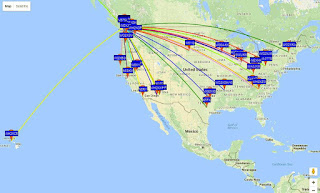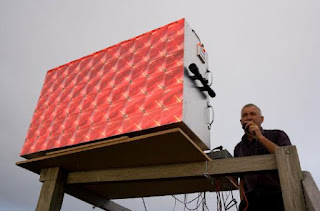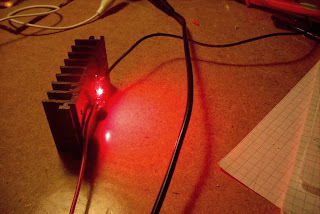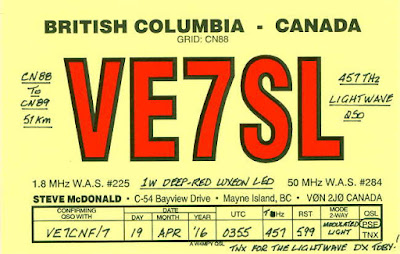Posts Tagged ‘VA7MM’
 September Prop Awakens
September Prop Awakens

As our sunsets start to come earlier and dawn arrives later and later, the sun's accelerated southerly excursion has brought sudden changes to 630m propagation.
This past weekend's CLE activity saw universally poor propagation as well as weather related QRN from lightning ... but as usual at this time of the year, things can change rapidly. Wednesday's overnight map of my own 630m WSPR activity illustrates why September propagation on LF and MF can often be spectacular and this is with just 65 watts total power output:
 |
| courtesy: http://wsprnet.org/drupal/ |
Among other things, the map indicates the growing interest among U.S. amateurs in the 630m band. Hopefully they won't have to wait too much longer, although I seem to be saying this more often than I would like to. It is of interest to note that even though these were WSPR reports, signal levels at most reporting stations were either into the 'audible CW' levels or at 'JT9 workable' levels ... all stations should be workable once the 630m ham band becomes a reality for all North Americans. Midwinter conditions over the next several years should see an abundance of transcontinental contacts on both CW and on JT9!
The east-west path is the bread and butter direction for interesting possibilities, when it comes to those of us in VE7 land. Normally it only really sets in when geomagnetic conditions are quiet but, as a result of coronal hole streaming, this week's geomagnetic field has been anything but quiet. As John Langridge, KB5NJD / WG2XIQ reported today in his invaluable '630m daily reports':
The geomagnetic field was extremely active, with many reporting periods at storm levels. The Bz is pointing to the South and solar wind velocities are very high, peaking at 700 km/s. This event is significant and I am just glad to see that it is helping and not hurting propagation. When will the bottom drop out? Clearly there is a lot going on here that we do not understand.
With stormy conditions continuing throughout the week, Friday's path to down-under enjoyed some enhancement as well, not unusual when the east-west path is disturbed. VK4YB's 90 watt signal was widely heard by several VE7's (VE7CNF, VA7MM and VE7BDQ) in the predawn hour, as Roger's signal peaked up briefly for several WSPR decodes.
 |
| courtesy: http://wsprnet.org/drupal/ |
As the coronal hole streaming continues, this morning's path to VK seemed even better along with a new antenna at VK4YB favoring the northwest:
12:24 VK4YB 0.475622 -21 VE7BDQ 11844 km
12:12 VK4YB 0.475621 -22 VE7BDQ 11844 km
12:08 VK4YB 0.475622 -17 VE7BDQ 11844 km
11:04 VK4YB 0.475622 -24 VE7BDQ 11844 km
11:02 VK4YB 0.475623 -22 VE7BDQ 11844 km
10:54 VK4YB 0.475623 -22 VE7BDQ 11844 km
12:28 VK4YB 0.475626 -21 VE7SL 11820 km
12:24 VK4YB 0.475625 -23 VE7SL 11820 km
11:54 VK4YB 0.475623 -25 VE7SL 11820 km
11:04 VK4YB 0.475623 -23 VE7SL 11820 km
11:02 VK4YB 0.475625 -26 VE7SL 11820 km
10:54 VK4YB 0.475626 -21 VE7SL 11820 km
11:22 VK4YB 0.475614 -28 VA7MM 11872 km
11:04 VK4YB 0.475614 -28 VA7MM 11872 km
11:02 VK4YB 0.475615 -33 VA7MM 11872 km
10:54 VK4YB 0.475615 -26 VA7MM 11872 km
I should mention that the other VE7 stations are all operating from noisy suburbs near Vancouver ... clearly fine examples of what can be done on 630m under less than ideal operating conditions and by paying close attention to system optimization. Please don't let living in the city stop you from enjoying the mysteries and challenges that our latest ham band has to offer ... as mentioned earlier, there is still much to be learned about using this band at amateur radio power levels and small backyard antennas. How exciting is that!
 630m – The Path To VK
630m – The Path To VK
 |
| Roger, VK4YB |
I've been exchanging e-mails lately with Roger, VK4YB, in Queensland, Australia.
Roger is located about 30 miles from the ocean and has been the only VK signal that I have been able to hear on 630m WSPR mode. He seems to have the strongest signal out of Australia on 630m with his 90 watts and 120' tree supported wire vertical. John, VE7BDQ, has been heard twice down under with his modest station running at the allowable 5W EIRP limit, being reported in the fall of 2015 and again this spring. As well, John has heard Roger, the only signal from VK that either of us has copied.
I would like to be able to run some schedules with Roger in the fall, when transpacific paths should peak again. With that in mind, construction has begun on a new 630m transverter that will allow me to drive my present FET amplifier at full EIRP. Our schedules will utilize the JT9 weak signal mode, similar to JT65 but designed for the noisier LF and MF bands. It uses about 10% of the bandwidth that a JT65 signal requires, about 15Hz, and gains about 2db more sensitivity. A two-way QSO, under the best conditions, would take four minutes if all went well. A typical exchange of the required information, if initiated at my end, would look something like this:
VK4YB VE7SL
VE7SL VK4YB -20
R -18
RR 73
73 73 (not really needed but indicates RR received)
The path from my end is difficult as I am on the east side of Mayne Island and in Roger's direction, about one mile from a 600' hill directly in line with VK. Any RF heading Roger's way will need to leave here at a fairly high angle, which is likely the case anyway considering the low and short (in terms of wavelength) inverted-L antenna.
The path profile from here to the open Pacific Ocean is shown below, with my end being on the right edge, just behind those two hills. The rest of the obstructions are on Saltspring Island and then Vancouver Island, before hitting open water.
 |
| VE7SL To VK4YB courtesy: Hey What's That Path Profiler |
 |
| W7IUV To VK4YB courtesy: Hey What's That Path Profiler |
 |
| To VK4YB courtesy: Hey What's That Path Profiler |
The path from John, VE7BDQ, already heard in VK, is also easier than from here. Not far from the water, John has a pretty clear shot across Georgia Strait, giving his signal lots of time to gain altitude and clear those pesky Vancouver Island peaks.
 |
| VE7BDQ To VK4YB courtesy: Hey What's That Path Profiler |
 |
| VE7CNF To VK4YB courtesy: Hey What's That Path Profiler |
 |
| VA7MM To VK4YB courtesy: Hey What's That Path Profiler |
 |
| VE7CA To VK4YB courtesy: Hey What's That Path Profiler |
 |
| VK4YB Path To Pacific courtesy: Hey What's That Path Profiler |
As the solar activity slowly abates (but not this week!), propagation on 630m will slowly get better and better ... hopefully along with increased levels of Canadians transmitting on the band, and lots of stations in the USA. It is hoped that our enthusiastic neighbours to the south aren't too far away from getting the band fairly soon. Better get those soldering irons warmed-up so you are all ready to go!
 Lightwave Madness
Lightwave Madness
 |
| The 288 km path courtesy: REAST |
One of the local lightwave builders, Mark (VA7MM), brought my attention to some outstanding lightwave work conducted several years ago, by a group of very dedicated amateurs in Tasmania.
A pair of articles describes their successful attempts to send signals, via cloudbounce, over the astounding distance of 288km (180mi), crossing Bass Strait between the north Tasmanian coast and southern Australia.
What did it take to transmit lightwave signals over such a distance? Basically a system similar to the ones recently employed in our own local lightwave experiments but on a grander scale ... much grander!
The receiver is based on one of the KA7OEI designs, with modifications to increase its sensitivity. The receiver, and several other designs, can be found on Clint's website here, probably the best source of information on amateur lightwave available anywhere.
 |
| The lightwave receiver courtesy: REAST |
 |
| The 10mm x 10mm rx APD courtesy: Hamamatsu |
The transmitter was also big, consisting of an array of 60 red Luxeon III LED's, similar to the Red Rebel Luxeons used in our own local tests. Each LED had its own 12cm square fresnel lens, heatsink and method of focusing. Certainly this was a mammoth project, by amateur lightwave standards.
 |
| The 60 LED TX array courtesy: REAST |
Earlier long-haul tests out to 209 km used the digital JT65 mode for signal decodes but the 288 km test used a fairly esoteric weak signal mode called WSC built on the Spectrum Lab software. This mode is capable of digging almost 20 db deeper into the noise than JT65, down to almost -50db.
An in depth description of the two long-haul events, including equipment schematics, can be found in "288 km Cloudbounce from Tasmania to the Australian Mainland" and in "209 km with Narrow Beamwidth Transmitter".
The 288 km crossing project evolved over several years and is all very well documented, from the first early steps, at the Radio and Electronics Association of Southern Tasmania's (REAST) website here.
This adventuresome project was largely the work of VK7MO, VK7JG, VK3HZ and VK7TW. Their work is most inspiring and much can be learned from seeing what they discovered when transmitting into the cloudy nighttime skies.
Such an endeavour as this makes the local, much shorter Georgia Strait crossing, seem like a cake-walk, but I can't imagine using anything that big and bright here without causing trouble ... it would probably appear much too 'laser-like' to talk one's way out of a jam. Pointing anything resembling a laser light into the air these days is simply begging for trouble.
I can however, envision a scaled-down version, perhaps consisting of an array of four Luxeons ... at least on my end of the path, but even pointing one of those from the city could be problematic. Perhaps any NLOS lightwave attempts across Georgia Strait will need to be well away from Vancouver and its two-million sets of eyes.
 A Second West Coast Lightwave Adventure
A Second West Coast Lightwave Adventure
 |
| 51km Path courtesy: https://www.google.ca/maps |
Toby, VE7CNF, successfully inaugurated his lightwave station earlier this week, on Monday night, completing a nice two-way CW contact between West Vancouver (CN89) and Mayne Island (CN88). The distance spanned was approximately 51km (32 miles), crossing atop the western edges of Vancouver and then across the Strait of Georgia, the body of water separating mainland BC from Vancouver Island.
The details of Toby's homebrew lightwave equipment are described on his web site here and are similar to the station at this end ... also described in earlier blogs. This was the same path covered in my two previous lightwave QSO's with Markus, VE7CA, described here.
Monday evening's weather was clear and calm but at this time of the year, true darkness is a long time coming. With a full-moon just a few nights away, the sky never did get very dark it seemed. I set up my end of the path late in the afternoon, just in front of the house.
VE7CNF/7 end showing the busy-looking site in operation.
Accompanying Toby to the mountain lookout location were VA7MM, his YL VA7MAY and Markus, VE7CA who initially scouted out and found this nice site for our original lightwave contacts. Thanks to Markus who snapped a picture of the diehard lightwave crew!
 |
| VA7MM, VA7MAY and VE7CNF |
Although Toby's signal was very strong, the lighting hum was strong enough to cause some receiver front-end desensing and slightly modulate Toby's CW signal with a touch of AC ripple. I did not notice this hum when working VE7CA at the same location a couple of years ago. It's possible that there was no snow on the ski-hill at the time and the lights were not turned on.
Moving the receiver just a few degrees to the west made a huge difference, as the hummy background noise level returned to the quiet hush of a dark sky.
Toby's recording of my signal is much cleaner as there are no bright lights when looking towards Mayne Island. It is really interesting to hear the rapid fading, almost a flutter, on my CW signal, as the light passes through various levels of ever-changing haze above the water.
Midway through our one hour QSO, Toby reported that my signal had dropped measurably as had his signal on my end. Although I could see no obvious clouds in the path, I did notice a red glow out in the Strait that had not been there earlier. When I turned off my transmitter, the glow disappeared, indicating that there was indeed some low level haze that had crept up on us, and enough to cause some signal absorption on the path. Thankfully signal levels returned to normal, and actually were a bit stronger, about fifteen minutes later, when the haze thinned and the skies had grown a little darker.
Towards the end of our QSO, I had the chance to test out my #2 receiver. It was built so that I could do some NLOS cloudbounce testing here on the island, without having to separate my main system's transmitter/receiver pairing. At the time, there were no lenses available from the overseas manufacturer, so my quest for a suitable lens led me to a local 'bargain style' hardware importer (Princess Auto), who had a good supply of $5 lenses. The lens seemed to function well in my local tests but it had never been put side-by-side with the higher quality lens in my main transceiver. As it turned out, the $5 lens worked very well, easily detecting the 51km signal although it didn't sound quite as loud since the receiver I built for it was intended to interface with my laptop and lacked the additional audio amp I had built for the main system.
A final interesting observation was made, when on a whim, I placed a large cardboard shield over the bottom quarter of the transceiver's receiver lens. The signal strength didn't appear to change at all. I gradually blocked more and more of the lens but astonishingly, was still able to copy Toby's CW with all but a 1" strip of the lens completely covered! This would tend to indicate that we would be able to communicate with a very much smaller Fresnel or optical glass lens, such as a 4" or even a 2" inch magnifier. As I commented to Toby on CW, the possibilities for experimentation are endless.
All-in-all it was a very successful evening and the mountain-top gang seemed to enjoy the outing as much as I did, and ... the QSL is in the mail.
Hopefully there are other VE7's in or around Vancouver that might be interested in throwing a signal over this way some night ... I'll leave the light on for ya!
 Local Lightwave Activity / A New 630m Resource Site
Local Lightwave Activity / A New 630m Resource Site
 |
Toby, VE7CNF, has sent me some mail indicating that his new lightwave system is ready for a two-way test!
His system is very similar to the ones built and deployed by myself and Markus, VE7CA, in late 2013. The culmination of that activity is described here, in 'On Making Nanowaves - Part 6'. Our lightwave QSO and homebrew gear were later described in a 'how to' article in the 'The Canadian Amateur' as well as in the newest edition of 'The Radio Amateur's Handbook' (2016).
Toby describes his most recent pre-QSO backyard testing:
The lightwave gear appears to be working well. Focus looks good and the
finder scopes are doing their job. There's a reflective sign high up on a
hydro tower 170 meters away that's handy for testing. It lights up bright
when the transmitter's on it.
Back scatter off the clouds above my house worked too. I heard my CW beacon, audible 339, off a patch on the clouds about 1 degree wide. I don't really know if it was clear air scatter from closer by, or scatter off the clouds, but the spot was small. That's with the tx on the front deck, and rx in the back.
I used Spectran to check the noise from city lights in my area. At QRSS10
speed there are spectral lines at 540, 600, and 660 Hz. They aren't too
strong, but those are some frequencies we should avoid.
 |
| VE7CNF's lightwave system - TX (L) & RX (R) |
Hopefully the weather will co-operate enough to allow us to make a two-way QSO later this week. Plans call for Toby to set up near the same location in West Vancouver used by VE7CA as it offers a clear LOS path to Mayne Island, 54km to the southwest.
 |
| 54km Georgia Strait crossing (courtesy: https://www.google.ca/maps) |
*****************************************************
Rik, ON7YD, has set up a new website devoted to information specific to 630m. His 472kHz.org site looks as if it will be a valuable resource for those looking to get information and a start on our new band. At present, there is some really great information regarding transmitters, antenna systems and calculating E(I)RP levels. Have a look!
 More VE7 Lightwave Activity
More VE7 Lightwave Activity
 Two more VE7's are well on their way to getting in on the lightwave fun in the Vancouver lower mainland region. Toby, VE7CNF, and Mark, VA7MM, are constructing stations similar to the ones built by myself and Markus, VE7CA.
Two more VE7's are well on their way to getting in on the lightwave fun in the Vancouver lower mainland region. Toby, VE7CNF, and Mark, VA7MM, are constructing stations similar to the ones built by myself and Markus, VE7CA.Toby and Mark live close enough that a clear-air scatter QSO between them might also be a possibility. Having another near-by amateur, or even in the same city, is a great source of motivation ... not to mention having someone else to actually talk to, once the system has been built.
Except for the LED focusing sled, Toby's fine-looking transmitter box and LED driver / modulator, are now complete. The receiver is next on the list. I believe this will use one of the inexpensive ($5) fresnels lenses, purchased locally at Princess Auto, that seems to work very well for the price.
| photos courtesy VE7CNF |














